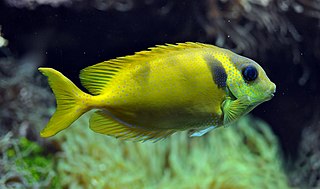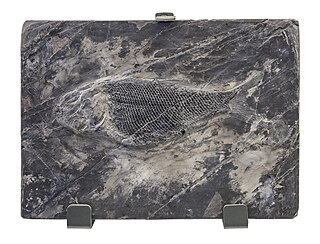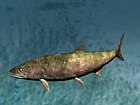
Actinopterygii, members of which are known as ray-finned fish or actinopterygians, is a class of bony fish that comprise over 50% of living vertebrate species. They are so called because of their lightly built fins made of webbings of skin supported by radially extended thin bony spines called lepidotrichia, as opposed to the bulkier, fleshy lobed fins of the sister class Sarcopterygii. Resembling folding fans, the actinopterygian fins can easily change shape and wetted area, providing superior thrust-to-weight ratios per movement compared to sarcopterygian and chondrichthyian fins. The fin rays attach directly to the proximal or basal skeletal elements, the radials, which represent the articulation between these fins and the internal skeleton.

The Amiiformes order of fish has only two extant species, the bowfins: Amia calva and Amia ocellicauda, the latter recognized as a separate species in 2022. These Amiiformes are found in the freshwater systems of North America, in the United States and parts of southern Canada. They live in freshwater streams, rivers, and swamps. The order first appeared in the Triassic, and the extinct members include both marine and freshwater species, many of which are morphologically disparate from bowfins, such as the caturids.

Neopterygii is a subclass of ray-finned fish (Actinopterygii). Neopterygii includes the Holostei and the Teleostei, of which the latter comprise the vast majority of extant fishes, and over half of all living vertebrate species. While living holosteans include only freshwater taxa, teleosts are diverse in both freshwater and marine environments. Many new species of teleosts are scientifically described each year.
Prof Erik Helge Osvald Stensiö HFRSE, né Andersson, was an influential Swedish paleozoologist and founder of the so-called "Stockholm School" of vertebrate paleontology. He later took his new surname, Stensiö, from his place of origin and is occasionally referred to with both names

Saurichthys is an extinct genus of predatory ray-finned fish from the Triassic Period. It is the type genus of the family Saurichthyidae, and the most speciose and longest lasting genus in the family. This family also includes the Permian Eosaurichthys (China) and the Jurassic Saurorhynchus from Europe and North America, though it may be more appropriate to treat these as subgenera of Saurichthys, due to the genus Saurichthys otherwise being paraphyletic.

Holostei is a group of ray-finned bony fish. It is divided into two major clades, the Halecomorphi, represented by the single living genus, Amia with two species, the bowfins, as well as the Ginglymodi, the sole living representatives being the gars (Lepisosteidae), represented by seven living species in two genera. The earliest members of the clade, which are putative "semionotiforms" such as Acentrophorus and Archaeolepidotus, are known from the Middle to Late Permian and are among the earliest known neopterygians.

Watsonulus is an extinct genus of prehistoric ray-finned fish that lived during the Early Triassic epoch in what is now Madagascar. It may have also existed in what is now Himachal Pradesh, India, during the Induan age. The type species, described by Jean Piveteau, is Watsonia eugnathoides. Because "Watsonia" was preoccupied, the new genus name Watsonulus was later erected. The genus is named after David Meredith Seares Watson.

Australosomus is an extinct genus of prehistoric ray-finned fish that lived during the Early Triassic epoch in what is now Greenland, Kenya, Tanzania, Madagascar, South Africa and Canada.

Asialepidotus is an extinct genus of prehistoric marine ray-finned fish that lived during the Ladinian stage of the Middle Triassic epoch. It contains a single species, A. shingyiensis, from Guizhou, China.

Parasemionotus is an extinct genus of prehistoric bony fish that lived in the Induan age of the Early Triassic epoch in what is now Madagascar. It is the name giving genus of the family Parasemionotidae and the order Parasemionotiformes.

Paracentrophorus is an extinct genus of prehistoric ray-finned fish that lived during the Induan age of the Early Triassic epoch in what is now Madagascar. The type species is Paracentrophorus madagascariensis (monotypy).

Thomasinotus is an extinct genus of small prehistoric ray-finned fish that lived in the Induan age of the Early Triassic epoch in what is now Madagascar. It belongs to the early neopterygian family Parasemionotidae together with Albertonia, Candelarialepis, Icarealcyon, Jacobulus, Lehmanotus, Parasemionotus, Qingshania, Stensioenotus, Suius, and Watsonulus.

Allolepidotus is an extinct genus of prehistoric marine neopterygian ray-finned fish from the Middle Triassic epoch of what is now Italy, Spain, and Switzerland. It was formerly referred to the halecomorph order Panxianichthyiformes, but is now thought to be a member of the Ionoscopiformes.

Bobasatrania is an extinct genus of prehistoric marine ray-finned fish that survived the Permian-Triassic extinction event. Fossils of Bobasatrania were found in beds of Changhsingian to Ladinian age. It was most speciose during the Early Triassic.

Boreosomus is an extinct genus of Triassic marine ray-finned fish. It was first described from the Arctic island of Spitsbergen, hence its genus name, but was later also discovered in other parts of the world. The type species is Boreosomus arcticus.

Colobodus is an extinct genus of marine Triassic ray-finned fish of the family Colobodontidae and order Perleidiformes. Fossils have been found in Europe and China, encompassing the former Tethys Ocean. It could reach body lengths of about 70 cm.

Saurichthyiformes is an extinct order of ray-finned fish which existed in Asia, Africa, Australia, Europe and North America, during the late Permian to early Middle Jurassic. Saurichthyiiformes comprise two families, Saurichthyidae and Yelangichthyidae. Yelangichthyidae is monotypic, containing only the genus Yelangichthys. The gar or needlefish-like Saurichthyidae is primarily known from the genus Saurichthys. Additionally, the subgenera SaurorhynchusCostasaurichthys, Eosaurichthys, Lepidosaurichthys, and Sinosaurichthys are frequently used to group species, and are sometimes considered separate genera. Species are known from both marine end freshwater deposits. They had their highest diversity during the Early and Middle Triassic. Their phylogenetic position is uncertain, while they have often been considered members of Chondrostei, and thus related to living sturgeons and paddlefish, phylogenetic analysis of well-preserved remains has considered this relationship equivocal. They may actually belong to the stem-group of Actinopterygii, and thus not closely related to any living group of ray-finned fish.

Ptycholepiformes are an extinct order of prehistoric ray-finned fish that existed during the Triassic period and the Early Jurassic epoch. The order includes the genera Acrorhabdus, Ardoreosomus, Boreosomus, Chungkingichthys, Ptycholepis, and Yuchoulepis. Although several families have been proposed, some studies place all these genera in the same family, Ptycholepididae.

Bobasatraniiformes is an extinct order of durophagous ray-finned fish that existed from the late Permian to the Middle Triassic in both marine and freshwater environments. The order includes two families: Bobasatraniidae, with the genera Bobasatrania, Ebenaqua, and Ecrinesomus, and Dorypteridae, comprising only the genus Dorypterus (monotypy). Bobasatraniiformes had a somewhat global distribution; fossils are found in Africa (Madagascar), Asia (Pakistan), Australia, Europe, and North America.

Halecomorphi is a taxon of ray-finned bony fish in the clade Neopterygii. The only extant Halecomorph species are the bowfin and eyespot bowfin, but the group contains many extinct species in several families in the order Amiiformes, as well as the extinct orders Ionoscopiformes, Panxianichthyiformes, and Parasemionotiformes. The fossil record of halecomorphs goes back at least to the Early Triassic epoch.





























